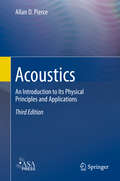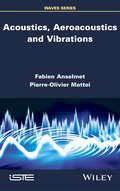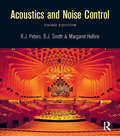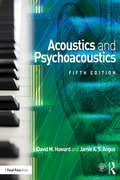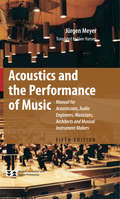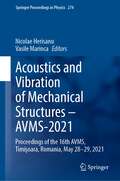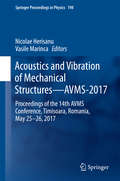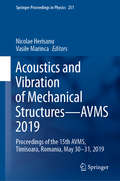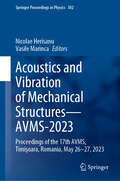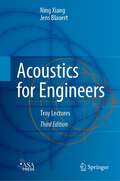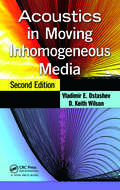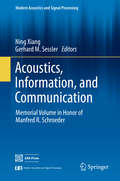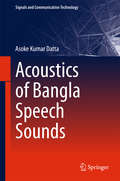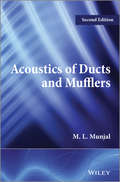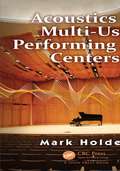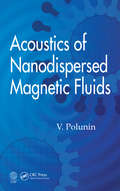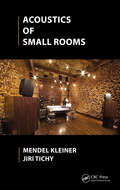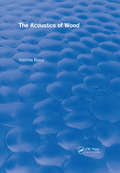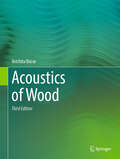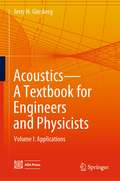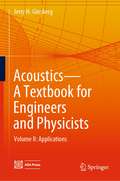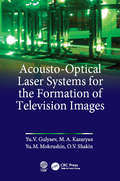- Table View
- List View
Acoustics: An Introduction to Its Physical Principles and Applications (Physical Acoustics Ser. #Volume 19)
by Allan D. PierceThis corrected version of the landmark 1981 textbook introduces the physical principles and theoretical basis of acoustics with deep mathematical rigor, concentrating on concepts and points of view that have proven useful in applications such as noise control, underwater sound, architectural acoustics, audio engineering, nondestructive testing, remote sensing, and medical ultrasonics.Since its publication, this text has been used as part of numerous acoustics-related courses across the world, and continues to be used widely today. During its writing, the book was fine-tuned according to insights gleaned from a broad range of classroom settings. Its careful design supports students in their pursuit of a firm foundation while allowing flexibility in course structure. The book can easily be used in single-term or full-year graduate courses and includes problems and answers. This rigorous and essential text is a must-have for any practicing or aspiring acoustician.
Acoustics, Aeroacoustics and Vibrations
by Pierre-Olivier Mattei Fabien AnselmetThis didactic book presents the main elements of acoustics, aeroacoustics and vibrations. Illustrated with numerous concrete examples linked to solid and fluid continua, Acoustics, Aeroacoustics and Vibrations proposes a selection of applications encountered in the three fields, whether in room acoustics, transport, energy production systems or environmental problems. Theoretical approaches enable us to analyze the different processes in play. Typical results, mostly from numerical simulations, are used to illustrate the main phenomena (fluid acoustics, radiation, diffraction, vibroacoustics, etc.).
Acoustics and Noise Control
by R J PetersAcoustics and Noise Control provides a detailed and comprehensive introduction to the principles and practice of acoustics and noise control. Since the last edition was published in 1996 there have been many changes and additions to standards, laws and regulations, codes of practice relating to noise, and in noise measurement techniques and noise control technology so this new edition has been fully revised and updated throughout. The book assumes no previous knowledge of the subject and requires only a basic knowledge of mathematics and physics. There are worked examples in the text to aid understanding and a range of experiments help students use complicated apparatus. Thoroughly revised to cover the latest changes in standards, codes of practice and legislation, this new edition covers much of the Institute of Acoustics Diploma syllabus and has an increased emphasis on the legal issues relating to noise control.
Acoustics and Psychoacoustics
by David M. Howard Jamie AngusThe acoustics of a space can have a real impact on the sounds you create and capture. Acoustics and Psychoacoustics, Fifth Edition provides supportive tools and exercises to help you understand how music sounds and behaves in different spaces, whether during a performance or a recording, when planning a control room or listening space, and how it is perceived by performers, listeners, and recording engineers. With their clear and simple style, Howard and Angus cover both theory and practice by addressing the science of sound engineering and music production, the acoustics of musical instruments, the ways in which we hear musical sounds, the underlying principles of sound processing, and the application of these concepts to music spaces to create professional sound. This new edition is fully revised to reflect new psychoacoustic information related to timbre and temporal perception, including an updated discussion of vocal fold vibration principles, samples of recent acoustic treatments, and a description of variable acoustics in spaces, as well as coverage of the environment’s effect on production listening, sonification, and other topics. Devoted to the teaching of musical understanding, an accompanying website (www.routledge.com/cw/howard) features various audio clips, tutorial sheets, questions and answers, and trainings that will take your perception of sound to the next level. This book will help you: Gain a basic grounding in acoustics and psychoacoustics with respect to music audio technology systems Incorporate knowledge of psychoacoustics in future music technology system designs as appropriate Understand how we hear pitch, loudness, and timbre Learn to influence the acoustics of an enclosed space through designed physical modifications
Acoustics and the Performance of Music: Manual for Acousticians, Audio Engineers, Musicians, Architects and Musical Instrument Makers (Modern Acoustics and Signal Processing #Vol. 729)
by Uwe Hansen Jürgen MeyerThis classic reference on musical acoustics and performance practice begins with a brief introduction to the fundamentals of acoustics and the generation of musical sounds. It then discusses the particulars of the sounds made by all the standard instruments in a modern orchestra as well as the human voice, the way in which the sounds made by these instruments are dispersed and how the room into which they are projected affects the sounds.
Acoustics and Vibration of Mechanical Structures – AVMS-2021: Proceedings of the 16th AVMS, Timişoara, Romania, May 28-29, 2021 (Springer Proceedings in Physics #274)
by Nicolae Herisanu Vasile MarincaThis book is a collection of contributions presented at the 16th Conference on Acoustic and Vibration of Mechanical Structure held in Timişoara, Romania, May 28, 2021. The conference focused on a broad range of topics related to acoustics and vibration, such as noise and vibration control, noise and vibration generation and propagation, effects of noise and vibration, condition monitoring and vibration testing, modelling, prediction and simulation of noise and vibration, environmental and occupational noise and vibration, noise and vibration attenuators, biomechanics and bioacoustics. The book also discusses analytical, numerical and experimental techniques applicable to analyze linear and non-linear noise and vibration problems (including strong nonlinearity) and it is primarily intended to emphasize the actual trends and state-of-the-art developments in the above mentioned topics. The primary audience of this book consist of academics, researchers and professionals, as well as PhD students concerned with various fields of acoustics and vibration of mechanical structures.
Acoustics and Vibration of Mechanical Structures—AVMS-2017: Proceedings of the 14th AVMS Conference, Timisoara, Romania, May 25–26, 2017 (Springer Proceedings in Physics #198)
by Nicolae Herisanu Vasile MarincaThis book is a collection of papers presented at Acoustics and Vibration of Mechanical Structures 2017 - AVMS 2017 - highlighting the current trends and state-of-the-art developments in the field. It covers a broad range of topics, such as noise and vibration control, noise and vibration generation and propagation, the effects of noise and vibration, condition monitoring and vibration testing, modeling, prediction and simulation of noise and vibration, environmental and occupational noise and vibration, noise and vibration attenuators, as well as biomechanics and bioacoustics. The book also presents analytical, numerical and experimental techniques for evaluating linear and non-linear noise and vibration problems (including strong nonlinearity). It is primarily intended for academics, researchers and professionals, as well as PhD students in various fields of the acoustics and vibration of mechanical structures.
Acoustics and Vibration of Mechanical Structures—AVMS 2019: Proceedings of the 15th AVMS, Timisoara, Romania, May 30–31, 2019 (Springer Proceedings in Physics #251)
by Nicolae Herisanu Vasile MarincaThis book contains selected and expanded contributions presented at the 15th Conference on Acoustics and Vibration of Mechanical Structures held in Timisoara, Romania, May 30-31, 2019. The conference focused on a broad range of topics related to acoustics and vibration, such as analytical approaches to nonlinear noise and vibration problems, environmental and occupational noise, structural vibration, biomechanics and bioacoustics, as well as experimental approaches to vibration problems in industrial processes. The different contributions also address the analytical, numerical and experimental techniques applicable to analyze linear and non-linear noise and vibration problems (including strong nonlinearity) and they are primarily intended to emphasize the actual trends and state-of-the-art developments in the above mentioned topics. The book is meant for academics, researchers and professionals, as well as PhD students concerned with various fields of acoustics and vibration of mechanical structures.
Acoustics and Vibration of Mechanical Structures—AVMS-2023: Proceedings of the 17th AVMS, Timişoara, Romania, May 26–27, 2023 (Springer Proceedings in Physics #302)
by Nicolae Herisanu Vasile MarincaThis book presents peer-reviewed and selected papers from the 17th Conference on Acoustics and Vibration of Mechanical Structures (AVMS) held in Timisoara, Romania, on 26–27 May 2023. Internationally recognized experts share their knowledge and key findings in a broad range of topics related to acoustics and vibration of mechanical structures such as analytical, numerical and experimental techniques for noise and vibration problems, environmental and occupational noise and vibration, modelling, prediction and simulations of noise and vibration, noise and vibration control, noise and vibration attenuators. The book addresses application studies and fundamental studies as well, and it is meant for academics researchers and professionals, as well as Ph.D. students concerned with various fields of acoustics and vibration of mechanical structures.
Acoustics for Engineers: Troy Lectures
by Ning Xiang Jens BlauertThis textbook provides materials for an introductory course in Engineering Acoustics for students with a basic knowledge of mathematics. The contents are based on extensive teaching experience at the graduate level. Each of the 14 main chapters deals with a well-defined topic and represents the material for a two-hour lecture. The chapters alternate between more theoretical and more application-oriented concepts. The presentation is organized to be suitable for self-study as well.For this third edition, the complete text and many figures have been revised. Several current amendments take account of advancements in the field. Further, a completely new chapter has been added which presents approaches and solutions to all assigned exercise problems. The new chapter offers the opportunity to explore the underlying theoretical background in more detail. However, the study of the problems and their proposed solutions is no prerequisite for comprehending the material presented in the book's lecture part.
Acoustics in Moving Inhomogeneous Media
by Vladimir E. Ostashev D. Keith WilsonIntroduces Systematic Formulations for Use in Acoustic ApplicationsAcoustics in Moving Inhomogeneous Media, Second Edition offers a uniquely complete and rigorous study of sound propagation and scattering in moving media with deterministic and random inhomogeneities. This study is of great importance in many fields including atmospheric and oceanic
Acoustics, Information, and Communication: Memorial Volume in Honor of Manfred R. Schroeder (Modern Acoustics and Signal Processing)
by Ning Xiang Gerhard M. SesslerThis book explores the life and scientific legacy of Manfred Schroeder through personal reflections, scientific essays and Schroeder's own memoirs. Reflecting the wide range of Schroeder's activities, the first part of the book contains thirteen articles written by his colleagues and former students. Topics discussed include his early, pioneering contributions to the understanding of statistical room acoustics and to the measurement of reverberation time; his introduction of digital signal processing methods into acoustics; his use of ray tracing methods to study sound decay in rooms and his achievements in echo and feedback suppression and in noise reduction. Other chapters cover his seminal research in speech processing including the use of predictive coding to reduce audio bandwidth which led to various code-excited linear prediction schemes, today used extensively for speech coding. Several chapters discuss Schroeder's work in low-peak factor signals, number theory, and maximum-length sequences with key applications in hearing research, diffraction gratings, artificial reverberators and de-correlation techniques for enhancing subjective envelopment in surround sound. In style, the articles range from truly scientific to conversationally personal. In all contributions, the relationship between the current research presented and Manfred Schroeder's own fields of interest is, in general, evident. The second part of the book consists of Schroeder's own memoirs, written over the final decade of his life. These recollections shed light on many aspects not only of Schroeder's life but also on that of many of his colleagues, friends and contemporaries. They portray political, social and scientific events over a period that extends from pre-war to the present. These memoirs, written in an inimitable and witty style, are full of information, entertaining and fun to read, providing key insight into the life and work of one of the greatest acousticians of the 20th century.
Acoustics of Bangla Speech Sounds (Signals and Communication Technology)
by Asoke Kumar DattaThis book presents the consolidated acoustic data for all phones in Standard Colloquial Bengali (SCB), commonly known as Bangla, a Bengali language used by 350 million people in India, Bangladesh, and the Bengali diaspora. The book analyzes the real speech of selected native speakers of the Bangla dialect to ensure that a proper acoustical database is available for the development of speech technologies. The acoustic data presented consists of averages and their normal spread, represented by the standard deviations of necessary acoustic parameters including e. g. formant information for multiple native speakers of both sexes. The study employs two important speech technologies:(1) text to speech synthesis (TTS) and (2) automatic speech recognition (ASR). The procedures, particularly those related to the use of technologies, are described in sufficient detail to enable researchers to use them to create technical acoustic databases for any other Indian dialect. The book offers a unique resource for scientists and industrial practitioners who are interested in the acoustic analysis and processing of Indian dialects to develop similar dialect databases of their own.
Acoustics of Ducts and Mufflers
by M. L. MunjalFully updated second edition of the premier reference book on muffler and lined duct acoustical performance Engine exhaust noise pollutes the street environment and ventilation fan noise enters dwellings along with fresh air. People have become conscious of their working environment. Governments of most countries have responded to popular demand with mandatory restrictions on sound emitted by automotive engines, and a thorough knowledge of acoustics of ducts and mufflers is needed for the design of efficient muffler configurations. This fully updated Second Edition of Acoustics of Ducts and Mufflers deals with propagation, reflection and dissipation/absorption of sound along ducts/pipes/tubes, area discontinuities, perforated elements and absorptive linings that constitute the present-day mufflers and silencers designed to control noise of exhaust and intake systems of automotive engines, diesel-generator sets, compressors and HVAC systems. It includes equations, figures, tables, references, and solved examples and unsolved exercises with answers, so it can be used as a text book as well as a reference book. It also offers a complete presentation and analysis of the major topics in sound suppression and noise control for the analysis and design of acoustical mufflers, air conditioning and ventilation duct work. Both the fundamentals and the latest technology are discussed, with an emphasis on applications. Deals with reactive mufflers, dissipative silencers, the frequency-domain approach, and the time-domain approach. Fully updated second edition of the premier reference book on muffler and lined duct acoustical performance, in one complete volume Presents original new research on topics including baffle silencers and louvers, 3D analytical techniques, and flow-acoustic analysis of multiply-connected perforated-element mufflers Includes a general design procedure to help muffler designers in the automotive industry, exhaust noise being a major component of automobile and traffic noise pollution Written by an expert with four decades’ experience in teaching to graduate students, publishing extensively in reputed international journals, and consulting with industry for noise control as well as designing for quietness
Acoustics of Multi-Use Performing Arts Centers
by Mark HoldenMulti-use performing arts centers are among the most complex of all building types and require excellent and flexible acoustics in order to suit the facility's varied programming needs. This technical and practical book by renowned acoustician Mark Holden delivers a full discussion of the challenges and solutions that arise in the concept, design, construction and commissioning phases. It serves students, architects, engineers, designers and acousticians.
Acoustics of Nanodispersed Magnetic Fluids
by V. PoluninAcoustics of Nanodispersed Magnetic Fluids presents key information on the acoustic properties of magnetic fluids. The book is based on research carried out by the author as well as on many publications in both the Russian and foreign scientific literature from 1969 onwards.It describes a wide variety of topics, which together lay the foundation of
Acoustics of Small Rooms
by Mendel Kleiner Jiri TichyMuch time is spent working out how to optimize the acoustics of large rooms, such as auditoria, but the acoustics of small rooms and environments can be just as vital. The expensive sound equipment of a recording studio or the stereo in a car or living room is likewise rendered useless if the acoustic environment is not right for them.Changes in wa
The Acoustics of Wood (CRC Press Revivals)
by Voichita BucurAcoustics of Wood offers a detailed treatment of numerous topics that are valuable to those working with wood in architecture, engineering, acoustics, and the crafting of musical instruments. It presents a comprehensive account of the progress and current knowledge concerning wood acoustics, outlining the anatomy and physiology of wood and the specific applications in which its acoustic properties are relevant. Acoustics of Wood reviews state-of-the-art measurement systems and includes material that has not been widely published. Divided into three main parts, the book describes environmental acoustics, presents acoustics methods for the characterization of the elastic behavior of wood, and discusses acoustic methods for the assessment of wood quality.
Acoustics of Wood
by Voichita BucurThe Third Edition of Acoustics of Wood offers a comprehensive overview of advanced acoustical techniques for wood characterization and assessment. It stands as an authoritative guide on using ultrasound and acoustic emissions to assess and characterize wood's physical and mechanical properties. Divided into six parts, this extended and updated edition covers a broad spectrum of topics including ultrasonic wave propagation, nondestructive testing methods for wood characterization, and the innovative use of acoustics in quality assessment of wood products. It also explores the acoustic properties vital for musical instruments and the application of acoustics in preserving historically significant art objects and timber structures. With chapters on cutting-edge topics like artificial intelligence's role in wood acoustics, readers are invited to explore the intersection of tradition and technology. Targeted at professionals and researchers in materials science, engineering, and conservation, this edition is invaluable for those seeking to deepen their knowledge of wood's acoustic properties. Readers with a background in physics or engineering will find the discussions on ultrasonic techniques and acoustic emissions particularly enlightening. By bridging theoretical concepts with practical applications, this book not only enriches scientific understanding but also opens up new avenues for innovation in wood assessment and preservation.
Acoustics-A Textbook for Engineers and Physicists: Volume I: Fundamentals
by Jerry H. GinsbergThis textbook provides graduate and advanced undergraduate students with a comprehensive introduction to the application of basic principles and concepts for physical and engineering acoustics. Many of the chapters are independent, and all build from introductory to more sophisticated material. Written by a well-known textbook author with 39 years of experience performing research, teaching, and mentoring in the field, it is specially designed to provide maximum support for learning. Derivations are rigorous and logical, with thorough explanations of operations that are not obvious. Many of the derivations and examples have not previously appeared in print. Important concepts are discussed for their physical implications and implementation. Many of the 56 examples are mini case studies that address systems students will find to be interesting and motivating for continued study. The example solutions address both the significance of the example and the reasoning underlying the formulation. Tasks that require computational work are fully explained. This volume contains 168 homework exercises, accompanied by a detailed solutions manual for instructors. Building on the foundation provided in Volume I: Fundamentals, this text offers a knowledge base that will enable the reader to begin undertaking research and to work in the core areas of acoustics.
Acoustics-A Textbook for Engineers and Physicists: Volume II: Applications
by Jerry H. GinsbergThis textbook provides graduate and advanced undergraduate students with a comprehensive introduction to the application of basic principles and concepts for physical and engineering acoustics. Many of the chapters are independent, and all build from introductory to more sophisticated material. Written by a well-known textbook author with 39 years of experience performing research, teaching, and mentoring in the field, it is specially designed to provide maximum support for learning. Derivations are rigorous and logical, with thorough explanations of operations that are not obvious. Many of the derivations and examples have not previously appeared in print. Important concepts are discussed for their physical implications and implementation. Many of the 56 examples are mini case studies that address systems students will find to be interesting and motivating for continued study. The example solutions address both the significance of the example and the reasoning underlying the formulation. Tasks that require computational work are fully explained. This volume contains 168 homework exercises, accompanied by a detailed solutions manual for instructors. Building on the foundation provided in Volume I: Fundamentals, this text offers a knowledge base that will enable the reader to begin undertaking research and to work in the core areas of acoustics.
Acousto-Optical Laser Systems for the Formation of Television Images
by Yu V. Gulyaev M. A. Kazaryan M. Mokrushnin O.V. ShatkinThe book addresses various approaches to television projection imaging on large screens using lasers. Results of theoretical and experimental studies of an acousto-optic projection system operating on the principle of projecting an image of an entire amplitude-modulated television line in a single laser pulse are presented. Characteristic features of image formation and requirements for individual components are discussed. Particular attention is paid to nonlinear distortions of the image signal, which show up most severely at low modulation signal frequencies. The feasibility of improving the process efficiency and image quality using acousto-optic modulators and pulsed lasers is studied.
Acquired Tastes: Stories about the Origins of Modern Food (Food, Health, and the Environment)
by Benjamin R. Cohen, Michael S. Kideckel, and Anna ZeideHow modern food helped make modern society between 1870 and 1930: stories of power and food, from bananas and beer to bread and fake meat.The modern way of eating—our taste for food that is processed, packaged, and advertised—has its roots as far back as the 1870s. Many food writers trace our eating habits to World War II, but this book shows that our current food system began to coalesce much earlier. Modern food came from and helped to create a society based on racial hierarchies, colonization, and global integration. Acquired Tastes explores these themes through a series of moments in food history—stories of bread, beer, sugar, canned food, cereal, bananas, and more—that shaped how we think about food today. Contributors consider the displacement of native peoples for agricultural development; the invention of Pilsner, the first international beer style; the &“long con&” of gilded sugar and corn syrup; Josephine Baker&’s banana skirt and the rise of celebrity tastemakers; and faith in institutions and experts who produced, among other things, food rankings and fake meat.
Acquiring a Scientific Vocabulary: A Short Course for Building Lexical Literacy for Advancing AP and College Students
by Anthony M. BelmontA short course specifically designed for high school AP science students and college freshmen or sophomores in any science courses to provide an understanding of how scientific terminology is composed and to give students a 'ballpark' knowledge of terms t
Across a Star-Swept Sea
by Diana PeterfreundFrom Rampant and Ascendant author Diana Peterfreund comes this thrilling companion to For Darkness Shows the Stars. Centuries after wars nearly destroyed civilization, Persis Blake's world is once again in the throes of rebellion. For Persis, her public life is that of a socialite, filled with parties and ball gowns. But while she seems to be a frivolous aristocrat, inside Persis beats the heart of a spy—the same heart that is falling for the enemy, Justen Helo. Persis's heart belongs to Justen, but before she can tell him the truth, she discovers he has a secret as well—one that could plunge their tropical paradise into another dark age. And Persis realizes she's not just risking her heart, she's risking the world she's sworn to protect. Across a Star-Swept Sea is a romantic, science-fictional reimagining of the classic The Scarlet Pimpernel.
